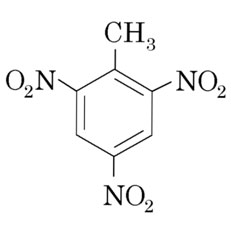 What is TNT?
What is TNT?
TNT is a yellow, odorless solid that does not occur naturally in the environment. It is made by combining toluene with a mixture of nitric and sulfuric acids. It is a highly explosive, single-ring nitro aromatic compound that is a crystalline solid at room temperature
Uses
TNT is one of the most widely used military high explosives, partly because of its insensitivity to shock and friction. It has been used extensively in the manufacture of explosives since the beginning of the 20th century and is used in military cartridge casings, bombs and grenades. In addition to military use, small amounts of TNT are used for industrial explosive applications, such as deep well and underwater blasting. Other industrial uses include chemical manufacturing as an intermediate in the production of dye stuffs and photographic chemicals.
Sources & Potential Exposure
TNT is commonly found at hand grenade ranges, antitank rocket ranges, artillery ranges, bombing ranges, munitions testing sites and open burn/open detonation. Production of TNT in the United States is currently limited to military arsenals; however, it may be imported into the United States for industrial applications. TNT can be released to the environment through spills, firing of munitions, disposal of ordnance, OB/OD of ordnance, leaching from inadequately sealed impoundments and demilitarization of munitions.
The compound can also be released from manufacturing and munitions processing facilities. The majority of TNT may be degraded in the surface soil at impact areas; however, small quantities can reach shallow groundwater. Potential exposure to TNT could occur by dermal contact or inhalation, and the likely route is exposure to contaminated soils. However, exposure to contaminated groundwater is also likely at sites with high infiltration rates, such as washout lagoons or OB/OD areas.
Federal Regulations
EPA has assigned TNT a weight-of-evidence carcinogenic classification of C (possible human carcinogen).

 Americas
Americas Europe
Europe Français
Français Deutsch
Deutsch Italiano
Italiano Español
Español
